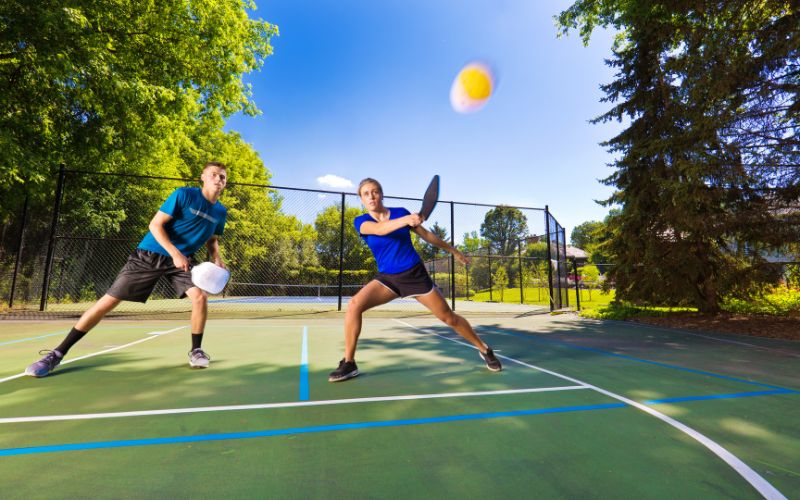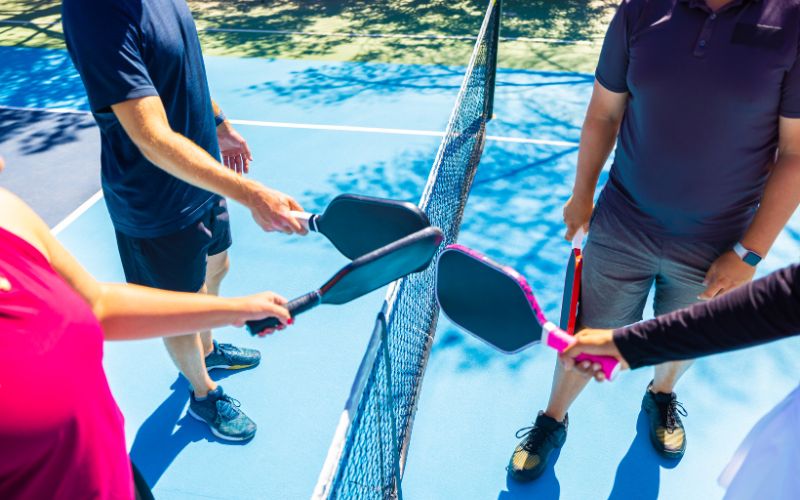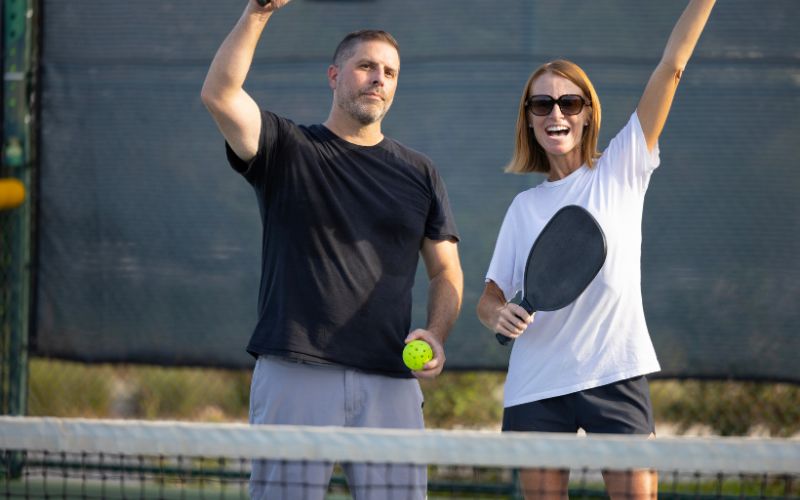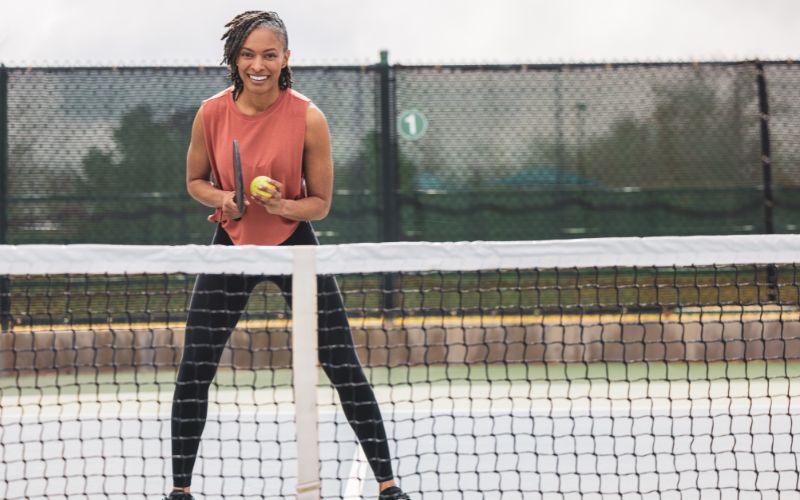Pickleball has surged in popularity, and doubles play is where the action truly heats up. The key to dominating the court in doubles pickleball lies in the elusive concept of court chemistry. This article delves into the Pickleball Strategies Doubles , transforming two players into a seamless unit of pickleball prowess.
Understanding Court Chemistry
Court chemistry is the intangible bond between partners that allows for anticipatory moves, seamless communication, and shared strategy execution. It’s the magic that happens when two players are so in sync that they move as one entity, covering the court with ease and confidence.
The Foundation of Synchronized Strategy when Playing Doubles Pickleball
To build court chemistry, players must first understand each other’s strengths, weaknesses, playing styles, and preferences. This understanding forms the foundation upon which all synchronized strategies are built.
The Synchronized Serve and Return
In doubles pickleball, the serve and return are the opening moves that can dictate the flow of the game. These initial shots set the stage for either an offensive or defensive strategy and require careful coordination between partners.
Serving with a Plan
When serving in doubles pickleball, it’s not just about getting the ball over the net; it’s about doing so with intention and strategy. The serving team must have a clear plan for who will cover which areas of the court once the ball is in play. This decision is often influenced by the players’ strengths and weaknesses, as well as the opponents’ observed tendencies.
A common strategy is stacking, where both players align on the same side of the court during the serve. This allows the serving team to position their stronger forehand in the middle of the court after the serve, ready to take on the return. For example, if one partner has a powerful forehand, they might serve from the left side of the court (for a right-handed player) and then move to the right, allowing them to use their forehand to dominate the center.
The serving team must also decide who will take responsibility for the ‘kitchen’ or non-volley zone and who will cover the baseline, preparing for any deep returns. This division of the court helps prevent confusion and ensures that each player knows their role as the point unfolds.
Returning with Intent
The return of serve is your first opportunity to seize control of the point. A well-executed return should be strategic, aiming to neutralize the server’s advantage and ideally, put the serving team on the defensive. The returning team must decide whether to return deep to push the servers back and prevent them from advancing to the net, or to drop it short, disrupting their rhythm and potentially drawing them out of position.
The returning team also needs to be in sync regarding movement. After the return, both players should move towards the net together to establish their presence and take control of the non-volley zone. This coordinated advance can apply pressure and force the serving team into a defensive posture.
In both serving and returning, the key is synchronization between partners. Each player must be aware of the other’s movements and shots, moving in harmony to cover the court effectively. This requires not only physical coordination but also a mental connection, anticipating each other’s moves and adapting to the flow of the game in real-time.
The Third Shot and Beyond
The Third Shot Drop
The third drop shot is a pivotal moment in pickleball doubles. It’s a soft, arcing shot that lands in the kitchen, allowing the serving team to advance to the net.
The Drive
Alternatively, a third shot drive can be used to apply pressure, but it requires precise coordination between partners to cover the court effectively.
Court Positioning and Movement
Dynamic Positioning
In doubles pickleball, positioning and movement are dynamic. Partners must constantly adjust their positions based on the ball’s location and their opponents’ movements.
Synchronized Movement
Synchronized lateral movement is essential. When one player moves, the other adjusts accordingly, maintaining optimal court coverage and positioning.
Communication: The Glue of Court Chemistry
Verbal and Non-Verbal Signals
Communication in doubles team pickleball is not just about calling the ball. It includes a range of verbal and non-verbal signals that partners use to coordinate their play.
Pre-Point Planning
Before each point, partners should have a quick discussion about their strategy. This ensures both players are on the same page and know what to expect from each other.
Advanced Strategies
The Stack
Stacking is a strategy where both players stand on the same side of the court during the serve and return. This allows players to play to their forehand or backhand preference.
The Switch
The switch is a dynamic play where partners switch sides during a point to confuse opponents or to put themselves in a better position to play their strengths.
Pickleball Doubles Strategy
Targeting your opponent’s feet in doubles pickleball
By directing the ball towards the opposing team’s feet, you create a challenging shot that is effective regardless of their position on the court. This tactic forces opponents to hit upward, reducing their chances of a strong return, especially for less experienced players who may struggle with low shots.
For effective drinks aimed at the feet, use a paddle with an open face to gently push or lift the ball, focusing on control and placement over power. Minimize any backswing to keep your shots discreet and to quickly return to a ready stance.
This approach is particularly useful when opponents are at the baseline, hindering their advance to the net, or in the transition area, where it can disrupt their positioning. To maintain the element of surprise, vary your shots and angles, ensuring you don’t become predictable.
Mastering the drop shot
Mastering drop shot can significantly improve your pickleball play. It’s a strategic move, often used as the third shot, to catch opponents off balance. The key is a gentle touch to land the ball in the kitchen without setting up the opponent for a smash. Practice by starting with dinks and gradually moving back to the baseline. Effective drop shots can disrupt opponents’ attacks and help you gain control of the kitchen, potentially swinging the momentum in tough matches.
Serve Deep and Consistent
A deep serve in pickleball pushes opponents back, limiting their offensive options and allowing the serving team time to position themselves, often moving up to the net. Consistently serving deep can mentally pressure opponents, causing frustration and errors as they struggle with difficult returns.
This strategy also minimizes the serving team’s errors, maintaining pressure that can disrupt opponents’ focus and technique. In doubles, both partners must synchronize with this strategy, with the non-serving partner ready to capitalize on the anticipated weaker return, helping to control the game’s tempo.
Perfect the Third Shot Drop
The third shot drop is a crucial skill in doubles. It’s a soft shot that lands in the non-volley zone, or ‘kitchen’, giving you and your partner time to move forward to the net.
Communicate with Your Partner
In doubles pickleball, strong communication is vital. It’s not just about calling shots but maintaining a dialogue to stay coordinated. Quick, clear communication is essential for deciding who takes the ball, especially in the middle of the court, to prevent confusion or collisions.
Effective communication also involves strategy discussions, motivational support, and non-verbal cues like hand signals and eye contact. Teams that communicate effectively can better coordinate, cover the court, and intimidate opponents, making communication a practiced and valued skill in the sport.
Adopt the Stack Strategy
Stacking in doubles pickleball is a strategy where both players align on the same court side to exploit their forehand power. This setup ensures optimal forehand use during critical plays, particularly in the court’s center.
It’s beneficial during serves and returns, allowing quick transitions to preferred positions and a forehand-dominant stance. While stacking enhances forehand shots and can unsettle unaccustomed opponents, it demands practice for seamless position shifts without leaving the court vulnerable. Properly executed, stacking offers a strategic advantage by optimizing forehand use and court coverage.
Control the Net
In doubles pickleball, net control is a powerful strategy that shapes the game. Holding the net with your partner cuts down opponents’ return angles and sets you up for aggressive volleys and smashes. It forces opponents into less threatening shots and keeps them under pressure.
Effective net play requires you and your partner to move as one, protecting all areas and staying alert to lobs. Dominating the net increases your offensive options and can be pivotal in securing points and dictating the game’s tempo.
Master the Dink Game
Dinking is a soft, controlled shot that lands in the kitchen. It’s a strategic move that can force errors from your opponents or set up a more aggressive shot for you and your partner.
Develop a Strong Defense
A solid defensive strategy can turn the tide of a game. Be ready to transition from offense to defense smoothly, and work with your partner to cover the court effectively.
Use Lobs Sparingly but Effectively
In doubles pickleball, lobs are a strategic shot that can disrupt your opponents’ net play by forcing them to retreat to the baseline. Effective lobs are high enough to be out of reach but precise enough to land near the baseline.
Use them sparingly to avoid predictability and to prevent setting up your opponents for a powerful smash. Employ lobs thoughtfully to surprise your opponents and to add variety to your game.
Implement Side-to-Side Movement
In doubles pickleball, side-to-side movement is essential for solid defense and setting up attacks. Partners moving in sync cover the court better, leaving fewer openings for opponents. This coordinated movement allows for quick responses to various shots and a seamless shift from defense to offense.
It also maintains the strategic up-and-back formation, with one player ready for volleys and the other for deeper shots. More than agility, it’s about the partners’ mental sync and silent communication, making their court coverage efficient and their teamwork formidable.
Practice Patience
Sometimes, the best strategy is to wait for the right opportunity to attack. Patience can pay off by forcing your opponents to make the first mistake, giving you the advantage.
In the fast-paced world of doubles pickleball, the fusion of individual skills into a unified front is the essence of victory. This article has explored the intricacies of synchronized strategies that turn two players into a formidable force, emphasizing the alchemy of court chemistry. From the strategic serve and return to the nuanced third-shot drop, each play is a testament to the power of partnership.
Communication, both verbal and non-verbal, serves as the team’s lifeline, guiding movements and fortifying defenses. The stack strategy and net control are but pieces of a larger puzzle where each player’s strengths are amplified through meticulous coordination. I
Implementing side-to-side movement, mastering the dink game, and employing lobs and drop shots with precision all contribute to the dance of doubles pickleball. As players weave these strategies into their game, they transform the court into a canvas of tactical brilliance, proving that in the realm of pickleball doubles, unity is not just strength—it’s victory.
Frequently Asked Questions
How do you develop court chemistry with a new partner?
Developing court chemistry takes time and practice. Play as many games as possible together, discuss strategies, and review your games to identify areas for improvement.
What is the most important aspect of synchronized strategy in doubles?
Communication is the most important aspect. Without clear and constant communication, even the best strategies can fall apart.
Can you switch serving strategies mid-game?
Yes, you can switch serving strategies mid-game, but it should be communicated clearly between partners to avoid confusion.





